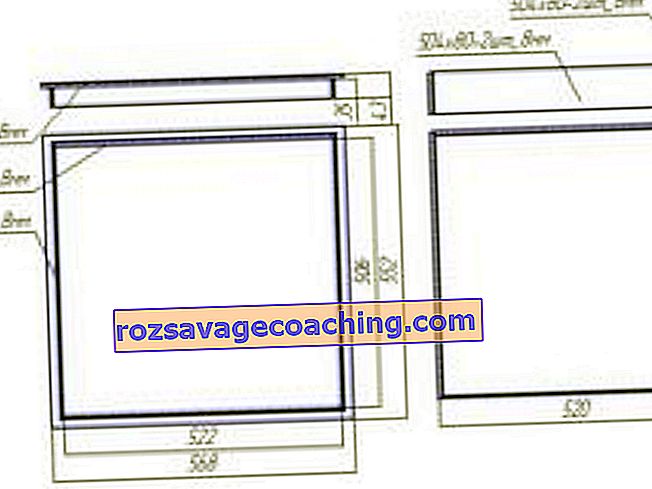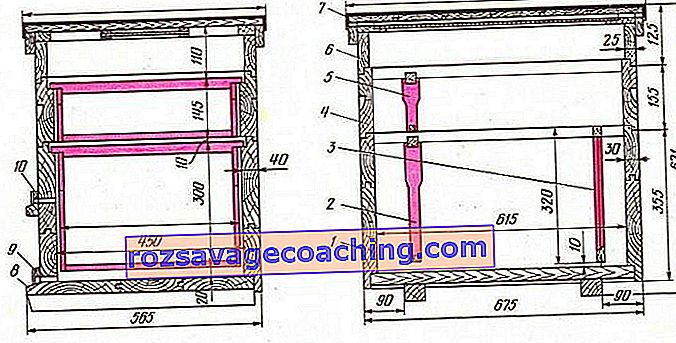
The book "A Short Course in Beekeeping" by Charles Dadant, a famous American entrepreneur and beekeeper, described a new beehive invented by the author, known today by his name. The design of the hive embodied all the most modern achievements of beekeeping of the middle of the last century, combining them with the most elementary methods of building hives and optimal methods of operation.



History of creation
Charles studied bees for a long time and came to the conclusion that 3000 eggs are laid by a young queen in a day, and a healthy swarm of bees can fill 1500 built honeycombs in 24 hours. That is, the normal life of a bee colony requires the installation of more than a dozen semi-wide Queenby frames, which must be placed inside one housing. This will provide the swarm with sufficient space to accommodate the collected honey.


Such a hive turned out to be so easy to use that its popularity went beyond the borders of the country and reached the countries of Europe. Subsequently, it turned out that the climate of the United States is milder than the European wintering conditions for the bee colony, and this is precisely what required certain improvements. For this reason, the Swiss beekeeper Blatt proposed a scheme for using Langstroth frames with an increase in their number to a dozen. Later, E. Bertan made the last improvement, which brought the Dadant hive to its modern form.
Although the Dadan hive is highly efficient, it is hardly produced on an industrial scale, although it is very willingly made for themselves by novice beekeepers. It is easy to manufacture, such a beehive can easily be made for himself by anyone, without spending money on factory models.

Advantages and disadvantages
Of course, any design has a set of certain pros and cons. Let's turn to the pros:
- separating diaphragm allows placing two bee colonies in one hive;
- elementary construction, where the most affordable materials are used;
- various layout options;
- one large bee colony is kept together;
- the built-in store allows you to increase the collection of honey;
- there is no need to carry the upper case, which has a lot of weight;
- frame inspection is not very difficult;
- when swarming, you can create layering.
The main disadvantage is the slow development of bees in the spring period of the year. In addition, the entire structure is inconvenient to move due to its bulkiness and significant weight.
As can be seen from the comparison, beekeepers should still thank the inventors for taking into account many details that make the life of bee colonies easier in this type of hive. For this reason, beekeepers on many continents are happy to use this hive building system.






Dimensions and Drawings
As for the drawings and dimensions, the Dadant hive, being a prefabricated modular structure, is composed of:
- a case in which the bottom can be separated or not;
- store extension;
- roof liner;
- roofs;
- removable bottom (depends on the design);
- nesting and shop frames;
These typical elements allow you to make several types of structures. The most common are models consisting of:
- from a body with a removable bottom, two store extensions for collecting honey and a roof with a sub-roof;
- from a body equipped with a non-removable bottom, store extension, under-roof liner, roof;
- from two bodies, a detachable bottom, a roof and a sub-roof.
How to assemble the hive body with your own hands, see below.
For the manufacture of the Dadant hive , an exact drawing is required, in which all dimensions of the selected option must be indicated. It is best to have on paper and a separate sketch of each module, and general assembly drawings.
The classic version is the design of the hive with the installation of 12 low-wide frames. In the light version, only 10 frames are provided, and for the enlarged version there are 14. The manufacture of a larger version is intended mainly for beekeeping in those latitudes where low temperatures prevail.
The accepted dimensions of the nest frame are 435 mm by 300 mm, and the store frame is 435 mm by 145 mm. The gap between the frame strip and the hive wall should be 7 mm. For free subframe space, do not leave more than 2.5 cm, and the frame strip in width should not be wider than 37 mm. Accordingly, the height of the inner space is 325 mm and the length is 450 mm. The width of the structure is determined by the number of frames installed. Each store has a height of 165 mm, and the entrance is 12x10 mm.
The wooden walls of the main hive should not be thinner than 32 mm. When making a store, it is recommended to use less thin wood (up to 26 mm).
External measurements, which are useful when calculating the footage of the apiary area, are made based on the thickness of the materials used.


10-frame hives are popular due to the fact that their bodies are lighter and more compact. Their dimensions are 325 mm x 370 mm x 450 mm. magazine - 165 mm. The diameter of the tap holes is 12x100 mm, they can be adjusted in diameter.
The 12-frame Dadanov hive is considered classic. They are mainly used in areas with a relatively mild and warm climate, where there is no significant frost.
The most popular equipment includes a removable bottom of the case, the case itself, a store extension and a roof along with a sub-roof. The body must contain 12 frames 435 mm x 300 mm, the size of the frame for the store is 435x145 mm. The width of the overframe gap is 10 mm, the lower gap is 25 mm. Accordingly, the body will have dimensions - 325x445x450 mm, and the store - 160x445x450 mm.






The 14-frame Dadan hive is intended primarily for use in those Russian latitudes where temperatures are minimal. For this reason, it is insulated as much as possible. Since two additional frames were added, the internal width of the case had to be expanded by 75 mm, which was 510 mm.
Due to the more significant mass in this version of the hive, as a rule, two magazines are used, which replace the second hull, or the hive does not have any superstructure at all. The bottom has to be made double, it should include a flap and sheathing with a layer of thick paper laid between them.

Materials
Statistics show that the correct construction of the Dadant hive, made with high quality materials, should last at least 10 years. Therefore, for the installation of the hive you will need:
- high quality materials;
- high-precision processing of workpieces and assembly of modules;
- high-quality outer coating, the condition and integrity of which is constantly monitored.
When manufacturing it is recommended to use natural dry wood . Mostly deciduous (preferably fruit) tree species is used. Coniferous wood - pine or spruce - is used at least 12 months after harvesting, since it is imperative that most of the aromatic resins weather and crystallize.
For wood, the percentage of moisture is not higher than 15%.


In addition to pure wood, plywood is also used in the manufacture, which makes construction more expensive. The fact is that in this case only plywood marked with FC is used. In the manufacture of such plywood, one of the adhesives with a carbamide composition is used, which is environmentally friendly and harmless to bees. In such plywood, the first layer of veneer is made of linden or birch wood, and the rest are glued together from coniferous wood.
It is forbidden to use any type of glue with a strong smell.
The production of a multi-layer or double-walled frame structure, where the role of the outer surface will be played by a sheet of plywood of 4-5 mm thickness, will significantly reduce the cost of building a hive. Plywood sheets are fixed on a wooden frame, filling the space between them with dry sawdust, crushed foam or other types of dry insulation. The selection of the size of the bar will allow you to choose any thickness of the hive walls.


Another possibility is to use polystyrene sheets pasted over with plywood sheets on both sides. But it should be noted that here it is imperative to seal the end edges.


A lightweight structure can be made from materials such as expanded polystyrene or polyurethane foam. The bottom of such a structure will have to be equipped using some kind of durable material (board, plywood), since the porous material is only suitable for making walls or roofs.
Such material does not lend itself to decay, has excellent thermal insulation properties, but it can only be used in stationary hives on a personal plot. Unfortunately, these hives are very short-lived.
The coloring process has its own nuances that must be taken into account:
- coloring is carried out exclusively with products intended for external use;
- the surface is pre-primed twice without fail;
- all cracks and loose parts are putty with a substance based only on natural solvents.



Manufacturing of a 12-frame multi-body Dadanovsky hive
As already mentioned, you need to have sketches and a detailed drawing in a paper version available for clarity. Work is carried out only with workpieces with smooth, processed surfaces. To ensure a tight connection of parts with each other, their ends are sometimes milled to obtain longitudinal grooves and spikes, which subsequently must be coated with glue.
Build process:
- according to the drawing, the front, back and side walls are assembled;
- you need to accurately space the seams of the boards across the width - this will ensure greater strength of the finished hive;
- the front wall is drilled to make a taphole and obtain a lower ventilation hole;
- assemble the main body, it is recommended to connect the ends with nails or self-tapping screws;
- the bottom is assembled in the same way, not forgetting to set a protruding arrival bar;
- from the outside, everything is covered with water-repellent compounds (facade paint, varnish impregnation);
- the store is made in a manner similar to the manufacture of the body;
- the next step is to reinforce the strips on the upper contour of the store to install the frames;
- the manufacture of the roof liner and the fastening of the assembled shield is done strictly in accordance with the drawings;
- a tap hole is drilled in the under-roof, ventilation holes are on the sides;
- the body is installed on the bottom, a store is placed on top of the body and the finished hive is closed with a lid.
An example of making a 12-frame multi-body Dadanov hive is shown in the following video.